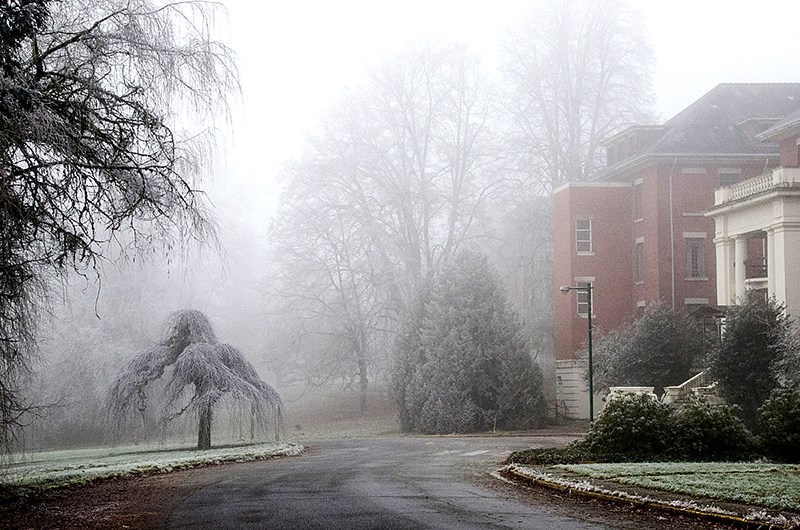Just before Christmas, BC Housing held a press conference at which it announced the provincial government was “restoring” mental health care to Riverview.
As with many such announcements, the devil is in the details.
The reality is the provincial government intends to now restrict mental health care facilities to only a small northern portion of this splendid 100-hectare site. The rest of the lands will be given over to intensive development, including a general residential area, a so-called “high street” — highrises? — and a large “economic development zone” right in the middle of one of the most beautifully landscaped areas at Riverview that is now graced by mature trees and many of its heritage buildings.
The very serviceable Valleyview hospital building will be demolished and two new buildings will be built to provide a net gain of only 17 new beds for mental health care at a cost of $175 million.
Valleyview hospital, opened in 1959, has a spacious and bright interior typical of most modern hospitals, with wide hallways and handrails to assist patients. Until four years ago, it provided much-needed beds for dementia patients with sunny rooms for occupational therapy and a special garden designed for them. It could easily provide about 200 beds for these seniors. Of all the buildings at Riverview, it would the easiest to return to use as a care facility. Instead, this building is the first to be targeted for destruction.
What sort of a message does that send about a commitment to renew Riverview?
When BC Housing assumed management of the Riverview site for the province, it promised to maintain all the existing open space. Members of the community were relieved to hear this as it meant the impressive tree collection would receive full protection.
The tree collection at Riverview is extremely valuable. It consists of about 1,800 mature trees representative of temperate zones throughout the world. Many of them have been planted in special botanical groupings or placed to highlight landscape features. Some arbourists have placed the worth of this tree collection at about $30 million — assuming, of course, it is possible to place a monetary value on such a spectacular collection of decades-old trees.
Initiated in the early 1900s by the first Professor of Botany at UBC, John Davidson, some of these trees were the first of their species to be planted in the Lower Mainland. Davidson went on to develop the botanical garden at UBC, for which he took plantings from Riverview.
To my profound chagrin, BC Housing is now reneging on its promise to protect all existing open spaces at Riverview. its promise now is to maintain as much of the site’s existing open space “as possible,” whatever that means. Furthermore, protection of the tree collection has been reduced to a vague promise to preserve the “core collection” of trees, with no definition of what constitutes this core.
In fact, a map included in the BC Housing’s vision document (available at www.renewingriverview.com) shows only a very small portion of the site will remain a “priority” for tree protection, with even smaller areas designated only for “consideration.” If these small areas are the only locations where tree protection will even be considered, Riverview could become a huge scar of mostly a clear-cut as new development proceeds.
Anyone who has attended one of the tree tours at Riverview understands this tree collection is integrated into the entire site. In fact, it is these wonderful trees, so thoughtfully planted by arbourists, who were truly landscape artists, which create the essence of what presently constitutes Riverview. To suggest anything less than full protection of these trees is tantamount to petty vandalism of a unique heritage site in the Lower Mainland.
BC Housing is also claiming its intensively developed vision of Riverview is what this community wants.
I beg to differ.
This time last year, BC Housing conducted a web-based survey of activities people wanted to see at Riverview. Strangely, BC Housing has never analyzed the results of this input received from about 600 people. Consequently, I undertook this analysis myself, which is now posted to www.bmn.bc.ca.
Briefly, public input clearly indicates 93% of those surveyed want mental health care to continue on site along with preservation of the tree collection (91%). More than 80% of participants supported a vision for Riverview that has residents who are mental health care patients, protects the environment through learning opportunities and provides skill-building activities for people with disabilities.
People were also very clear about what they thought did not belong at Riverview; this includes residential townhouses (69% opposed), retail mixed with residential (83% opposed) and Kwikwetlem First Nation (KFN) owning land at Riverview (88% opposed).
While there is no question the needs and desires of the Kwikwetlem First Nation must be addressed by the provincial government, I hope that the unique values of Riverview will not be undermined to assist this First Nation to achieve its long-term economic goals. Without a doubt, it will be a challenge for the province to reconcile the views expressed by community members and the stated objectives of Kwikwetlem to maximize economic development at Riverview. Hopefully, the province can find ways to bring economic benefits to Kwikwetlem First Nation without compromising the significant historical values that Riverview offers to the entire population of B.C.
BC Housing has invited members of the public to submit comments regarding this new vision for Riverview by Feb. 12. Comments can be submitted to [email protected] or submitted via a PlaceSpeak link provided on the renewingriverview.com website.
--Elaine Golds is a Port Moody environmentalist who is conservation/education chair of the Burke Mountain Naturalists and member of the boards of the Colony Farm Park Association and the Port Moody Ecological Society.



